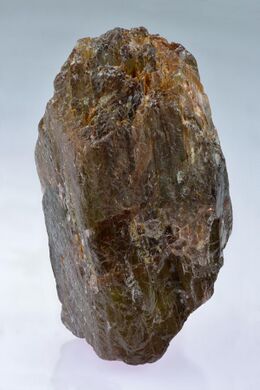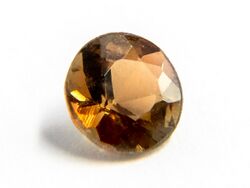Chemistry:Andalusite
| Andalusite | |
|---|---|
 Andalusite | |
| General | |
| Category | Nesosilicates |
| Formula (repeating unit) | Al2SiO5 |
| Strunz classification | 9.AF.10 |
| Crystal system | Orthorhombic |
| Crystal class | Dipyramidal (mmm) H-M symbol: (2/m 2/m 2/m) |
| Space group | Pnnm |
| Unit cell | a = 7.7980 Å, b = 7.9031 Å c = 5.5566 Å; Z = 4 |
| Identification | |
| Color | Pink, violet, yellow, green, white, gray; in thin section, colorless to pink or green |
| Crystal habit | As euhedral crystals or columnar aggregates having nearly square cross sections; fibrous compact to massive |
| Twinning | On {101}, rare |
| Cleavage | Good on {110}, poor on {100} |
| Fracture | uneven to subconchoidal |
| Mohs scale hardness | 6.5–7.5 |
| |re|er}} | Vitreous |
| Streak | White |
| Diaphaneity | Transparent to nearly opaque with inclusions |
| Specific gravity | 3.17 (± .04) |
| Optical properties | double refractive, biaxial negative; chiastolite has anomalous aggregate reaction.[1] |
| Refractive index | nα = 1.629 – 1.640 nβ = 1.633 – 1.644 nγ = 1.638 – 1.650 |
| Birefringence | δ = 0.009 – 0.010 |
| Pleochroism | strongly trichroic |
| 2V angle | 71–86° |
| Dispersion | r < v strong |
| Ultraviolet fluorescence | non-fluorescent |
| References | [1][2] |
Andalusite is an aluminium nesosilicate mineral with the chemical formula Al2SiO5. This mineral was called andalousite by Delamétehrie,[3] who thought it came from Andalusia, Spain. It soon became clear that it was a locality error, and that the specimens studied were actually from El Cardoso de la Sierra, in the Spanish province of Guadalajara, not Andalusia.[4]
Andalusite is trimorphic with kyanite and sillimanite, being the lower pressure mid temperature polymorph. At higher temperatures and pressures, andalusite may convert to sillimanite. Thus, as with its other polymorphs, andalusite is an aluminosilicate index mineral, providing clues to depth and pressures involved in producing the host rock.[5]
Varieties
The variety chiastolite commonly contains dark inclusions of carbon or clay which form a cruciform pattern when shown in cross-section. This stone was known at least from the sixteenth century, being taken to many European countries, as a souvenir, by pilgrims returning from Santiago de Compostela.[7]
Viridine is a green variety of andalusite in which manganese 3+ substitutes for aluminium, the same change is also responsible for the colour.[8][9] Kanonaite is a greenish-black mineral related to andalusite and having the approximate composition (Mn
0.76Al
0.23Fe
0.02)AlSiO
5.[10]
A clear variety found in Brazil and Sri-Lanka can be cut into a gemstone.[11] Faceted andalusite stones give a play of red, green, and yellow colors that resembles a muted form of iridescence, although the colors are actually the result of unusually strong pleochroism.[12]
Occurrence
Andalusite is a common metamorphic mineral which forms under low pressure and low to high temperatures. The minerals kyanite and sillimanite are polymorphs of andalusite, each occurring under different temperature-pressure regimes and are therefore rarely found together in the same rock. Because of this the three minerals are a useful tool to help identify the pressure-temperature paths of the host rock in which they are found. It is particularly associated with pelitic metamorphic rocks such as mica schist.[13]
Uses
Andalusite is used as a refractory in furnaces, kilns and other industrial processes.[14] South Africa possesses by far the largest portion of the world's known andalusite deposits.[15]
See also
References
- ↑ 1.0 1.1 Gemological Institute of America, GIA Gem Reference Guide 1995, ISBN:0-87311-019-6
- ↑ http://rruff.geo.arizona.edu/doclib/hom/andalusite.pdf Handbook of Mineralogy
- ↑ Delamétherie, Jean Claude (1798). "Sur une pierre de l'Andalousie". Journal de Physique, de Chimie d'Histoire Naturelle et des Arts 46: 386–387.
- ↑ Calvo, Miguel (2018). Minerales y Minas de España. Vol. IX. Silicatos. Madrid, Spain: Escuela Técnica Superior de Ingenieros de Minas de Madrid. Fundación Gómez Pardo. pp. 91–94. ISBN 978-84-8321-883-9.
- ↑ Whitney, D.L. (2002). "Coexisting andalusite, kyanite, and sillimanite: Sequential formation of three Al2SiO5 polymorphs during progressive metamorphism near the triple point, Sivrihisar, Turkey". American Mineralogist 87 (4): 405–416. doi:10.2138/am-2002-0404. Bibcode: 2002AmMin..87..405W.
- ↑ Whitney, D.L. (2002). "Coexisting andalusite, kyanite, and sillimanite: Sequential formation of three Al2SiO5 polymorphs during progressive metamorphism near the triple point, Sivrihisar, Turkey". American Mineralogist 87 (4): 405–416. doi:10.2138/am-2002-0404.
- ↑ Calvo, Miguel (2016). "El "lapis crucifer", "piedra de cruz de Compostela": un elemento importante de los patrimonios geológico y cultural del NW de España". De Re Metallica 6: 67–79.
- ↑ Abs-Wurmbach, I.; Langer, K.; Seifert, F.; Tillmanns, Ε. (1 October 1981). "The crystal chemistry of (Mn 3+ , Fe 3+ )-substituted andalusites (viridines and kanonaite), (Al 1-x-y Mn x 3+ Fe 3+ y ) 2 (O|SiO 4 ): crystal structure refinements, Mössbauer, and polarized optical absorption spectra". Zeitschrift für Kristallographie - Crystalline Materials 155 (1–4): 81–114. doi:10.1524/zkri.1981.155.14.81.
- ↑ "Minerals Colored by Metal Ions". http://minerals.gps.caltech.edu/color_causes/Metal_Ion/index.html.
- ↑ Vrána, S.; Rieder, M.; Podlaha, J. (1978). "Kanonaite, (Mn 0.76 3+ Al0.23Fe 0.02 3+ )[6]Al[5][O|SiO4], a new mineral isotypic with andalusite". Contributions to Mineralogy and Petrology 66 (3): 325–332. doi:10.1007/BF00373417.
- ↑ "International Colored Gem Association: Anadalusite". http://www.gemstone.org/gem-by-gem/english/andalusite.html.
- ↑ Fernandes, Shyamala; Choudhary, Gagan (Summer 2009). "Gem-quality andalusite from Brazil". Gems & Gemology 45 (2): 120–129. doi:10.5741/GEMS.45.2.120. https://www.gia.edu/doc/Summer-2009-Gems-Gemology-Gem-Quality-Andalusite-from-Brazil.pdf. Retrieved 30 October 2021.
- ↑ Nesse, William D. (2000). Introduction to mineralogy. New York: Oxford University Press. pp. 314–318. ISBN 9780195106916.
- ↑ Dubreuil, P.; Sobolev, V. M.; Filari, E. (1999). "Use Of Andalusite Refractories In Ferrous Metallurgy". Refractories and Industrial Ceramics 40 (5–6): 252–259. doi:10.1007/BF02762295. https://link.springer.com/article/10.1007/BF02762295. Retrieved 25 October 2021.
- ↑ Overbeek, P. W. (1 June 1989). "Andalusite in South Africa". Journal of the Southern African Institute of Mining and Metallurgy 89 (6): 157–171. https://journals.co.za/doi/abs/10.10520/AJA0038223X_1910. Retrieved 25 October 2021.
 |



